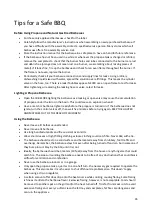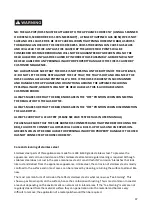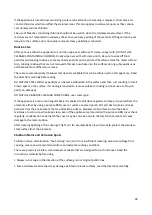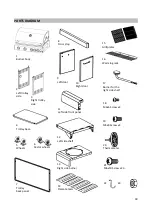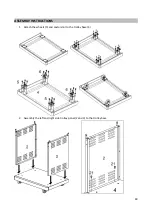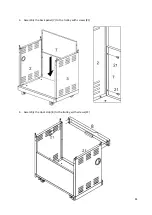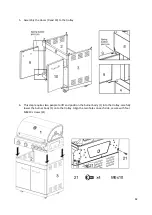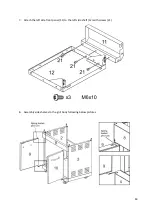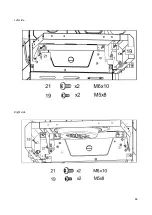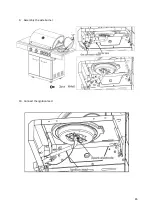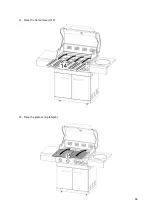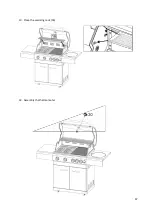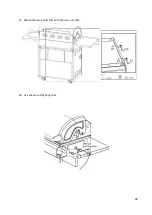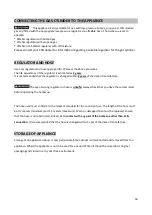
36
•
Do not operate the barbecue's rotisserie in damp or wet weather as it is connected to an electrical
outlet.
•
When finished with the barbecue, turn the knob valves off first, then the bottle. This allows the gas
in the lines to burn off.
•
After the barbecue has cooled off, cover it to protect it from the weather.
•
Keep a fire extinguisher close by. Never use water on a grease or fat fire as it only causes the flames
to spread. If fire surrounds the propane tank, leave the area immediately (to a distance of at least
200 meters from the tank) and call the fire department.
•
In case of a grease fire, leave the barbecue lid open and turn off the burners if you are able. If not,
turn off the gas supply at quick connect or the shut-off valve.
Transporting and Storing Portable Propane Tanks.
1.
Store propane tanks standing upright in a well-ventilated area outside or in a well-ventilated shed.
A leaking tank creates a potential fire hazard. Never store a propane tank in the house. An
explosion can be easily set off by a spark of static electricity, the flip of a light switch or a pilot light.
2.
NEVER smoke near a propane tank.
3.
Make sure the tank is stored out of the reach of children.
4.
Do not refill a tank that is leaking, is corroded or has any other signs of damage. Ask your propane
distributor to inspect the tank for signs of deterioration before it is refilled.
5.
When transporting a propane tank, make sure it remains in an upright position. Milk cartons work
well for this as they are just the right size to hug the tank securely. The best place for the tank to
travel is in the trunk of the car; secure the trunk lid so it remains slightly open for ventilation. The
tank can also be placed on the rear floor of the passenger side of the car; leave the rear windows
open for ventilation.
6.
When transporting a tank, use a plastic plug in the gas outlet for greater safety.
7.
Have the tank filled only by qualified personnel.
Grill Preparation and Safe Cooking.
•
Use hot, soapy water to clean all surfaces and utensils before and after preparing meats or poultry
products. Rinse well after washing.
•
To prevent food from sticking to the grill, brush the BBQ lightly with oil or spray with a nonstick
product.
•
Always use the proper utensils--long-handled--and oven mitts, if required.
•
If the weather is cool or damp or if it is windy, cooking time on the BBQ may be longer.
•
To reduce cooking time for meats and poultry, marinade them first. Marinating tenderizes the
meat, too. Try low-fat Italian dressing and soy sauces. These works well for indoor cooked meals,
too.
•
The BBQ should be preheated before starting to cook.
•
Keep the natural juices inside the meat or poultry. Turn with tongs or a spatula rather than
stabbing with a fork.
•
Use glazes or BBQ sauce during the last 15-20 minutes of cooking only. This well help prevent
burning.
•
When juices run clear from the meat and poultry, it can be removed from the grill.
•
Bon appetite!
Summary of Contents for GR-3C41A
Page 1: ......
Page 2: ...31...
Page 15: ...44 Left side Right side...
Page 16: ...45 9 Assembly the side burner 10 Connect the ignition lead...
Page 17: ...46 11 Place the flame tamers 14 12 Place the grates and plate 15...
Page 18: ...47 13 Place the warming rack 16 14 Assembly the thermometer...
Page 19: ...48 15 Attach the two hooks 22 with the two nuts 23 16 Use the manual lighting stick...
Page 30: ......






